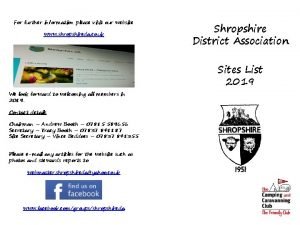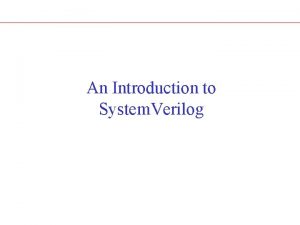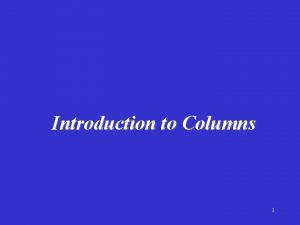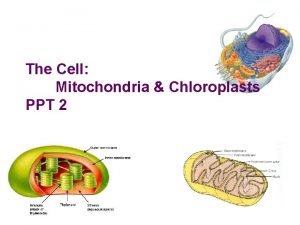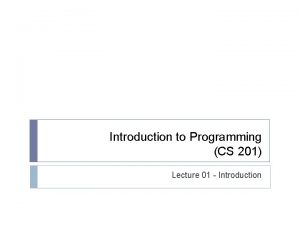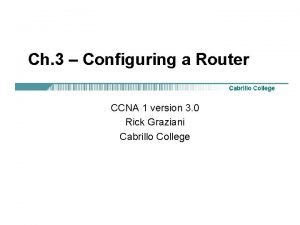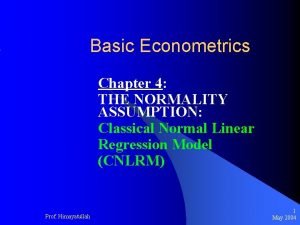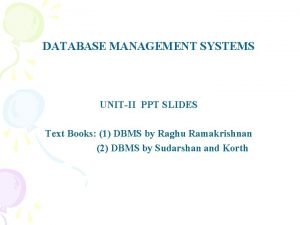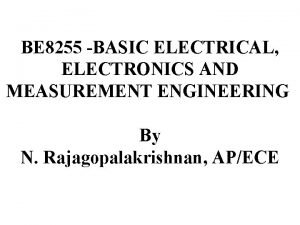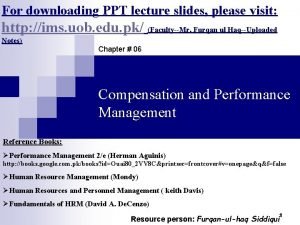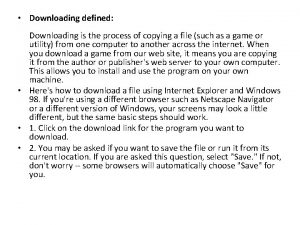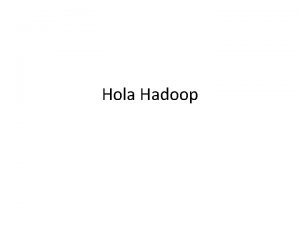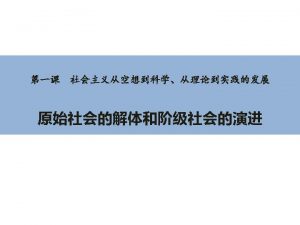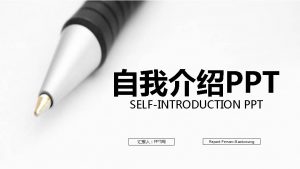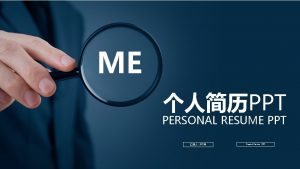For downloading PPT lecture slides please visit http


























- Slides: 26

For downloading PPT lecture slides, please visit: http: //ims. uob. edu. pk/ (Faculty--Mr. Furqan ul Haq--Uploaded Notes) Chapter 2 Classification Of Research References: • • • Business Research Methods (William G. Zikmund) VU Course Business Research Methods Internet Resource Person: Furqan-ul-haq Siddiqui

Different between Research & Investigation § § Research is a human activity based on intellectual investigation and is aimed at discovering, interpreting, and revising human knowledge on different aspects of the world. investigation you are required to make quarry for already happened events and bring the facts of the matter. Investigation is sort of finding hints or clues and moving forward.

CLASSIFICATION OF RESEARCH 1. Purpose of Doing Research a. b. c. Exploratory Research Descriptive Research Explanatory (Causal) Research 2. The Uses of Research a. b. i. iii. iv. 3. The Time Dimension in Research a. b. i. iii. Cross-Sectional Research Longitudinal Research A cohort analysis. Time Series Panel Study Basic Research 4. Research (data collection) Applied Research Techniques Used Action research a. Quantitative R&D b. Qualitative Impact Assessment Research Evaluation Research

CLASSIFICATION OF RESEARCH n n 1. 2. 3. 4. Before a researcher begins to conduct a study, he or she must decide on a specific type of research. For classification of research we shall look from four dimensions The purpose of doing research; The intended uses of research; How it treats time i. e. the time dimension in research; and The research (data collection) techniques used in it.

1. Purpose of Doing Research n ü ü ü Ø n I. III. n If we ask someone why he or she is conducting a study, we might get a range of responses: “My boss told me to do”; “It was a class assignment”; “I was curious. ” Simply there almost as many reasons to do research as there are researches. Yet the purposes of research may be organized into three groups based on what the researcher is trying to accomplish Explore a new topic, Describe a social phenomenon, Explain why something occurs. Studies may have multiple purposes (e. g. both to explore and to describe) but one purpose usually dominates

a. Exploratory/Formulative Research You may be exploring a new topic or issue in order to learn about it, you began at the beginning to clarify and define the nature of a problem. n Management may have discovered general problem but research is needed to gain better understanding of problems. n Exploratory research may be the first stage in a sequence of studies. n Subsequent researches expected. n n The results of exploratory research are not usually useful for decision-making by themselves, but they can provide significant insight into a given situation. Although the results of qualitative research can give some indication as to the "why", "how" and "when" something occurs, it cannot tell us "how often" or "how many. "

Goals of Exploratory Research: a. Become familiar with the basic facts, setting, and concerns; b. Develop well grounded picture of the situation; c. Develop tentative theories, generate new ideas, conjectures, or hypotheses; d. Determine the feasibility of conducting further study; e. Formulate questions and refine issues for more systematic inquiry; and f. Develop techniques and a sense of direction for future research. n

Categories of Exploratory Research Experience Surveys n Secondary Data Analysis n Case Studies n Pilot Studies n

Experience Surveys An exploratory research technique in which individuals who are knowledgeable about a particular research problem are surveyed Secondary Data Analysis Data that have been previously collected for same purpose other then problem at hand (Books, periodicals, government sources, internet, media)

i. Case Study Method Intensely investigates one or A few situations similar to the problem. Investigate in depth. Analyzing the similar situations already occurred. Pilot Study The use of small-scale diverse research techniques that involves sampling but doesn't apply rigorous standards. It includes Focus group Interview-A focus group is a gathering of 6 to 10 people who are carefully selected and invited to discuss relevant problem of interest in the presence of a moderator.

ii. Ø Ø Ø Projective Techniques- An indirect means of questioning that enables a respondent to project beliefs and feeling of 3 rd party. these are unstructured prompts or stimulus that encourage the respondent to project their underlying motivations, beliefs, attitudes, or feelings onto an ambiguous situation. They are all indirect techniques that attempt to disguise the purpose of the research includes Word Association Tests- Subject is presented with a list of words by Asking to respond with first word that comes to mind. Sentence Completion Method- respondents are given incomplete sentences and asked to complete them Story completion - respondents are given part of a story and are asked to complete it

Ø Ø iii. Third-person Technique- a verbal or visual representation of an individual and his/her situation is presented to the respondent is asked to relate the attitudes or feelings of that person - researchers assume that talking in the third person will minimize the social pressure to give standard or politically correct responses Role Playing- respondents are asked to play the role of someone else - researchers assume that subjects will project their own feelings or behaviors into the role T. A. T- respondents are shown a picture (or series of pictures) and asked to make up a story about the picture (s) that are assumed to reveal elements of his or her psychological makeup Picture Frustration/cartoon tests - pictures of cartoon characters are shown in a specific situation and with dialogue balloons - one of the dialogue balloons is empty and the respondent is asked to fill it in In-depth Interview- An extensive interview by experts used in primary stages of the research process.

b. Descriptive /Statistical Research Describe characteristics of a population or phenomenon. Ø Descriptive research seeks to determine the answers to who, what, when, where, and how questions. Although the data description is factual, accurate and systematic, the research cannot describe what caused a situation. Ø Labor Force Surveys, Population Census, and Educational Census are examples of such research. n

1. 2. 3. 4. 5. 6. Goals of Descriptive Research Describe the situation in terms of its characteristics i. e. provide an accurate profile of a group; Give a verbal or numerical picture (%) of the situation; Present background information; Create a set of categories or classify the information; Clarify sequence, set of stages; and Focus on ‘who, ’ ‘what, ’ ‘when, ’ ‘where, ’ and ‘how’ but not why.

c. Explanatory/Causal Research When we encounter an issue that is already known and have a description of it, we might begin to wonder why things are the way they are. The desire to know “why, ” to explain, is the purpose of explanatory research. n Subdivided in Causal research Conducted to identify cause and effect relationships Ø Laboratory Experiment Ø Field Experiment n

Goals of Explanatory Research 1. Explain things not just reporting. Why? Elaborate and enrich a theory’s explanation. 2. Determine which of several explanations is best. 3. Determine the accuracy of theory; test a theory’s predictions or principle. 4. Advance knowledge about underlying process. 5. Build and elaborate a theory; elaborate and enrich a theory’s predictions or principle. 6. Extend a theory or principle to new areas, new issues, new topics: 7. Provide evidence to support or refute an explanation or prediction. 8. Test a theory’s predictions or principles

2. The Uses of Research n a. o o Some researchers focus on using research to advance general knowledge, whereas others use it to solve specific problems. Basic Research- Investigation and analysis focused on a better or fuller understanding of a subject, phenomenon, or a basic law of nature in stead of on a specific practical application of the results. It does not directly involve the solution to a particular pragmatic problem. Just to consider how different problems that occur in organizational setup can be solved. Knowledge gained by the findings of basic research can be used by others. Verify the acceptability of a given theory.

b. o i. Applied Research- When research is done with the intention of applying the results of findings to solve the specific problem currently being experienced by organization. It is conducted when a decision must be made about a specific real-life problem. Types of Applied Research Action Research: It allows practitioners to address those concerns that are closest to them. In this, researcher wants to improve the way they address issues and solve problems. In larger organizations it is guided by professional researchers.

ii. iii. iv. Ø R & D: Research for development of new products or procedure or innovations. Impact Assessment Research: Its purpose is to estimate the likely consequences of a planned change. Such an assessment is used for planning and making choices among alternative policies. Eg. Impact of Basha Dam on the environment, impact of CNG on atmosphere of Quetta. Evaluation Research: It addresses the question, “Did it work? ” The process of establishing value judgment based on evidence about the achievement of the goals of a program, policy, or way of doing something. Two types of evaluation research are formative and summative. Formative evaluation is built-in monitoring or continuous feedback on a program used for program management. Summative evaluation looks at final program outcomes. Both are usually necessary

Applied Research Examples Uo. B conducts research on “Should faculty be promoted on the bases of seniority or on merit/educational base in Uo. B”? Ø Should ufone introduce a new post pay package? Ø A product is not selling in the market , to check the reasons & rectifying them. Ø SBP conduction research on how to control inflation in country Ø OPEC conducting research on how to control the prices of petrol around the glob. Ø 20

Basic Research Example Is executive success correlated with high need for achievement? n Are members of highly cohesive work groups more satisfied than members of less cohesive work groups? n Do consumers experience cognitive dissonance in low-involvement situations? n Causes of Inflation in Pakistan n 21

Difference Between Applied & Fundamental Research Applied Research is aimed at solving current problem. n Fundamental Research has more general objective of generating knowledge & understanding of organizational problems. n 22

3. The Time Dimension in Research Some studies give us a snapshot of a single, fixed time point it in detail & some studies provide a moving picture that lets us follow events, people, or sale of products over a period of time. a. Cross-Sectional Research. In cross-sectional research, researcher collects and analyses data at one specific point in time. ü The simplest and least costly. r cannot capture the change processes. Ø Cross-sectional research can be exploratory, descriptive, or explanatory, but it is most consistent with a descriptive approach to research. b. Longitudinal Research. Examining features of people or other units at more than one time. It is usually more complex and costly than cross-sectional research ü more powerful, especially when researchers seek answers to questions about change. There are three types of longitudinal research: time series, panel, and cohort. n

i. Time Series Research- In this same type of information is collected from a group of people or other units across multiple time periods. Researcher can observe stability or change in the features of the units or can track conditions overtime. ii. The panel study- In panel study, the researcher observes exactly the same people, group, or organization across time periods. It is a difficult to carry out such study. iii. A cohort analysis- is similar to the panel study, but rather than observing the exact same people, researcher collects information from people who have same nature, same characteristics etc.

4. Research (data collection) Techniques Used a. Quantitative b. Qualitative

CLASSIFICATION OF RESEARCH 1. Purpose of Doing Research a. b. c. Exploratory Research Descriptive Research Explanatory (Causal) Research 2. The Uses of Research a. b. i. iii. iv. 3. The Time Dimension in Research a. b. i. iii. Cross-Sectional Research Longitudinal Research A cohort analysis. Time Series Panel Study Basic Research 4. Research (data collection) Applied Research Techniques Used Action research a. Quantitative R&D b. Qualitative Impact Assessment Research Evaluation Research
 Downloading and accessing
Downloading and accessing Thank you for downloading
Thank you for downloading For further information please visit
For further information please visit Will you please be quiet please summary
Will you please be quiet please summary A small child slides down the four frictionless slides
A small child slides down the four frictionless slides Force and work relationship quick check
Force and work relationship quick check Principles of economics powerpoint lecture slides
Principles of economics powerpoint lecture slides Machine learning introduction slides
Machine learning introduction slides Business communication lecture slides
Business communication lecture slides 01:640:244 lecture notes - lecture 15: plat, idah, farad
01:640:244 lecture notes - lecture 15: plat, idah, farad Site initiation visit
Site initiation visit Disadvantages of home visiting
Disadvantages of home visiting Introduction to systemverilog
Introduction to systemverilog Acknowledgement powerpoint slide
Acknowledgement powerpoint slide Chloroplasts
Chloroplasts Cs201 ppt slides
Cs201 ppt slides Ccna 200-301 ppt slides download
Ccna 200-301 ppt slides download Mechatronics lecture notes ppt
Mechatronics lecture notes ppt Financial markets and institutions ppt
Financial markets and institutions ppt Slidetodoc download
Slidetodoc download Elements and principles of interior design ppt
Elements and principles of interior design ppt Gujarati basic econometrics lecture notes ppt
Gujarati basic econometrics lecture notes ppt Obstetrics and gynecology lecture notes ppt
Obstetrics and gynecology lecture notes ppt Additional features of er model ppt
Additional features of er model ppt Contemporary issues in supply chain management ppt
Contemporary issues in supply chain management ppt Be8255
Be8255 Project planning and management lecture notes ppt
Project planning and management lecture notes ppt


